eOrganic authors:
Dr. Joel Gruver, Western Illinois University
Dr. Ray R. Weil, University of Maryland
Charles White, Penn State University
Dr. Yvonne Lawley, University of Manitoba
Over the past decade, radishes have been redefined; once known almost exclusively as a pungent vegetable, radishes have recently gained recognition for their cover cropping potential. After reading this article, you'll be able to make an informed decision about whether cover crop radishes are worth a try on your farm.
Radishes have made rapid inroads as a cover crop for several reasons. First, the radish phenotype is well suited to perform many valuable cover crop functions—provide soil cover, scavenge nutrients, suppress weeds, and alleviate compaction—while creating few of the residue management challenges associated with many other cover crops. Second, recent research including many on-farm trials has documented beneficial effects of radish cover crops on soil properties and subsequent crops. Third, the seed industry has ramped up production of radish seed, brought new branded products to market, and promoted radish as a cover crop. Fourth—but perhaps most important in terms of the exponential growth in interest by farmers—radish cover crops have become a hot topic of discussion in rural coffee shops and on-line agricultural forums. Between 10/1/2011 and 12/1/2011, there were 51 threads about radishes in the Crop Talk forum of New Ag Talk, with over 500 responses and more than 240,000 views.
Radish Seedstock
Most of the radish varieties currently marketed for cover cropping (e.g., GroundHog radish™, Nitro radish, Sodbuster, and Bio-till radish) are large rooted selections of daikon-type oilseed or forage radishes, but are not the product of formal breeding programs. All are morphologically similar to the large white daikon radishes traditionally used in Asian cooking. Hybrid daikon-type culinary radish seed is prohibitively expensive (more than $100/lb for bulk seed) for use in cover cropping, but open pollinated culinary daikon varieties may have some potential with bulk seed available for about $5/lb. Standard oilseed radish cultivars (e.g., Adagio, Colonel, and Defender) tend to have a stubbier, more branched taproot, greater winter hardiness, and lower seed cost than larger-rooted daikon types (Ngouajio and Mutch, 2004).
There are currently 2 radish varieties marketed for cover cropping with certified genetics - Graza and Tillage Radish®. Graza from Pyne Gould Guinness Seeds (PGG, Ltd.) in New Zealand was developed over 17 years through a complex series of crosses of 3 species—garden radish (Raphanus sativus), cabbage (Brassica oleracea), and perennial seaside radish (Raphanus maritimus). The breeding program selected for smooth leaves, ability to recover from multiple grazings, and resistance to bolting. Graza will grow vegetatively for an extended period when spring planted unlike most other cover crop radishes. Compared to rape and forage turnips, Graza radishes have greater ability to respond to high fertility and build up larger root reserves, providing more resilience under difficult conditions (Stewart and Moorhead, 2004). Tillage Radish®, officially known as Variety CCS-779 received U.S. Plant Variety Protection status in June 2012. Unauthorized propagation of Graza and Tillage Radish® for seed production is strictly prohibited.
All radishes are insect pollinated and cross-pollinate easily, increasing the likelihood of genetic variability if not grown in strict isolation. In recent years, some farmers who purchased inexpensive radish seed have reported high levels of variability including early bolting.
In response to the growing interest in radishes for cover cropping, some public and private breeding programs are starting to select for radishes with superior cover crop attributes. More research is needed comparing radish varieties with respect to traits such as winter-hardiness, hard-seededness, seedling vigor, nutrient scavenging, root penetration strength, and biofumigation potential.
The information that follows should be generally applicable to all radish cultivars used for cover cropping unless otherwise noted. In addition, literature discussing other cool season annual brassica cover crops (e.g., a bulletin on the use of mustards as a biofumigant) may contain information that is relevant to managing radishes as a cover crop.
Benefits of Radish Cover Crops
Effects on Soil Structure
The radish attribute that has captured the most farmer interest is their robust rooting ability. Under favorable growing conditions, radish roots can extend more than 3 feet deep in 60 days, with the thickened storage portion of the root (commonly refered to as the tuber, though not botanically correct) extending more than 12 inches. Plants with roots more than 1 inch in diameter normally have a significant portion of the root exposed above ground (often more than 4 inches, even in uncompacted soils) (Fig. 1).
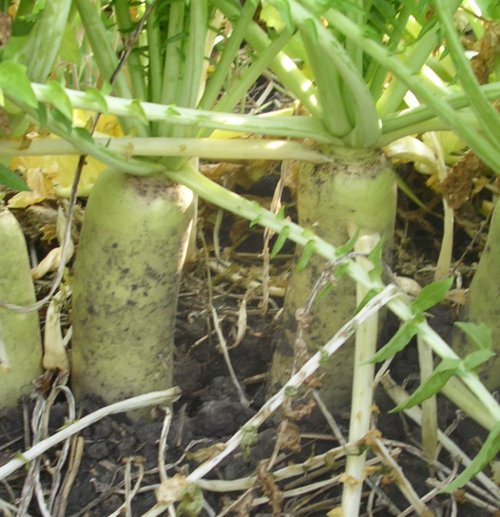
Figure 1. Typical above ground growth of the storage root after 60 days. Photo credit: Joel Gruver, Western Illinois University.
After radishes winter-kill and their large fleshy roots desiccate, the channels created by the roots tend to remain open at the soil surface, improving infiltration, surface drainage, and soil warming (Fig. 2). Radish rooting effects on soil porosity also extend into the subsoil. This general process called bio-drilling, can improve root growth by subsequent crops and access to subsoil moisture resulting in greater resilience under drought conditions (Chen and Weil, 2010).
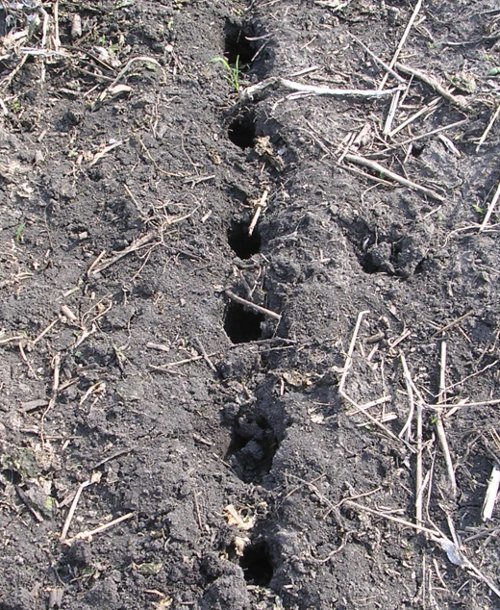
Figure 2. Radish holes after winterkill. Photo credit: Joel Gruver, Western Illinois University.
Research at the University of Maryland has shown that radish roots have greater ability to penetrate compacted soil than cereal rye and rapeseed (Chen and Weil, 2010). Subsequent research found twice as many corn roots penetrated compacted subsoil after radish cover cropping as compared to cereal rye, with both cover crops promoting more rooting than bare-fallow (Fig. 3). These results suggest that radishes may be useful as a biological alternative to deep ripping and other mechanical methods of alleviating soil compaction.
Some farmers and researchers are currently evaluating bio-strip-till strategies which involve targeted fall planting of radishes on the wide rows (e.g., 30") where a subsequent cash crop will be planted the next spring. This approach reduces seed cost and may maximize crop utilization of radish root channels but requires precise equipment guidance in the field. More information about bio-strip-till planting methods is contained in the section on seeding.
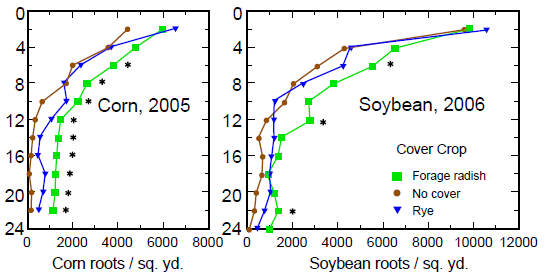
Figure 3. Enhanced corn and soybean root density following radish as compared to rye and no cover. Figure credit: Guihua Chen, University of Maryland.
Effects on Weeds
A good stand of radishes can eliminate nearly all weed growth both during and for some time after active radish growth (Fig. 4). To obtain near-complete weed suppression, radishes should be planted early (6 or more weeks before frost), at a relatively high population (more than 5 plants per square foot) into a clean seed bed. Weed suppression from fall planted radishes typically lasts into April, but does not extend much into the summer cropping season.
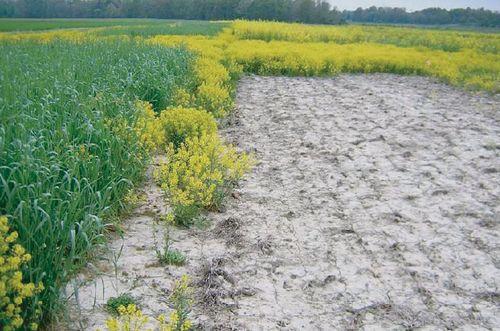
Figure 4. Near-complete suppression of weeds in April (Hayden Farm, Beltsville, MD). Photo credit: Yvonne Lawley, University of Manitoba.
Recent research at the University of Maryland investigated the mechanisms through which radishes provide weed suppression. Over ten site-years, they found that radishes provided complete suppression of winter annual weeds in the fall and early spring but the suppression did not persist into the summer crop. Controlled environment bioassays involving cover crop amended soil, aqueous plant extracts, and aqueous soil extracts along with a field experiment involving planted weed seeds did NOT provide evidence of allelopathy. In a residue moving experiment, no differences in spring weed suppression were observed if radish residues were removed prior to a killing frost in November or left in place to decompose (3 out of 4 site-years). These results were supported by planting date experiments where fall ground cover and spring weed suppression was greatest for the earliest radish planting dates. The University of Maryland researchers concluded that rapid and competitive fall growth, rather than allelopathy, is the primary mechanism of weed suppression by radishes (Lawley et al., 2011).
Effects on Seed Bed Preparation
After winter-kill (or other causes of mortality), radish residues deteriorate rapidly. As a result, fall biomass production is unlikely to interfere with spring field work. Typically a good stand of winter-killed radishes leaves the soil surface weed free and perforated with open root holes in early spring. As a result, the soil warms up and dries out faster than soils covered by either winter weeds or a growing cover crop and is conducive to earlier spring planting (Fig. 5).
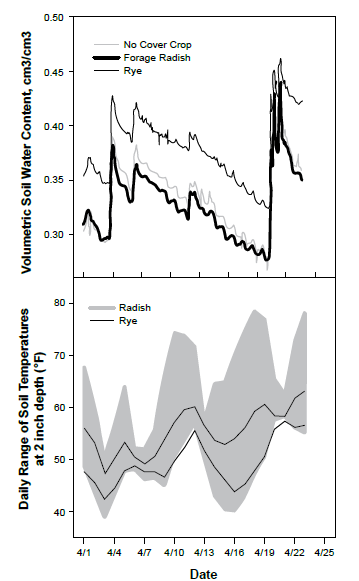
Figure 5. Warmer and drier seedbed in April with forage radish compared to rye as cover crop. Figure credit: Charlie White, Penn State University.
Effects on Nitrate Leaching
Because of their deep root system, rapid root extension, and heavy N feeding, radishes are excellent scavengers of residual N following summer crops (Fig. 6). Radishes take up N from both the topsoil and from deeper soil layers, storing the N in their shoot and root biomass. With favorable fall growing conditions, radishes typically take up more than 100 lb/ac of N. Much higher amounts of N may be acquired when N is abundant—for example, when a drought-stricken summer crop has failed to utilize much of the available N, when a field has a long history of manure applications, when a mature hay field has been plowed out, or when fertilizer has been applied to promote growth of the cover crop. Early planting promotes high biomass production and associated nutrient accumulation but research at the University of Maryland has shown that late planted radishes can still take up substantial quantities of N despite low biomass production due to shifts in plant C:N ratio (Dean and Weil, 2009).
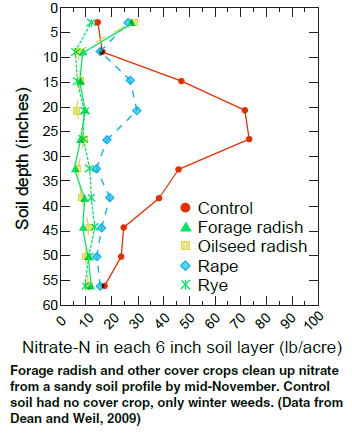
Figure 6. Scavenging of soil nitrate by radish. Figure credit: Ray Weil, University of Maryland.
Effects on Early Spring Nitrogen
Unlike cereal rye and other small grains whose residues decompose slowly and continue to immobilize N for an extended period, radish residues decompose and release N rapidly (Fig. 7). Timely crop establishment following radishes can result in an early boost in growth and N uptake similar to following a legume cover crop or N fertilizer application. In contrast, if planting is delayed (e.g., northern locations) and weather/soil conditions are conducive to leaching or denitrification, the availability of N scavenged by radishes to subsequent crops may be limited. Research at the University of Maryland found that early planting of spring crops following radish was more important on sandy soils than finer textured soils (Kremen, 2006). More research is needed to identify strategies for optimizing recycling of the N scavenged by radish cover crops (e.g., combining radishes with winter-hardy cover crop species).
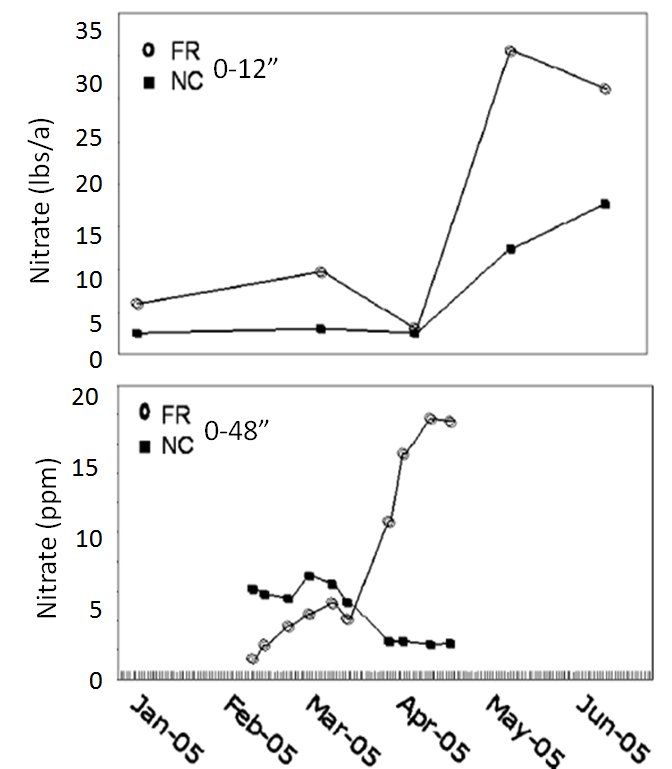
Figure 7. Spring release of N from radish residues (FR = following radish, NC = no cover). Figure credit: Ray Weil and Amy Kremen, University of Maryland.
Effects on Soil Phosphorus and Potassium
Radishes are excellent accumulators of P and K (root dry matter commonly contains more than 0.5% P and 4% K), and elevated levels of soil test P have been measured following radish cover cropping, particularly within 1–1.5 inches of radish root holes (White and Weil, 2011). Despite radish being a non-host of mycorrhizal fungi, mycorrhizal colonization of corn following radish does not appear to be suppressed (White and Weil, 2010).
Effects on Soil Erosion and Runoff
Radishes grow rapidly when planted in late summer or early fall and 10 lb/ac drilled on 7.5-inch rows can provide full canopy closure in about three weeks. This canopy intercepts rain drops minimizing surface impact and detachment of soil particles. Even after radishes are killed by a hard freeze, a layer of decomposing residue remains on the soil surface throughout the winter and into the early spring providing erosion control. In addition, runoff and sediment transport are reduced because of the rapid infiltration facilitated by open root holes. These holes can capture run-off and sediment before it leaves the field. For more complete protection against erosion, radish can be mixed with other cover crops that are winter hardy (e.g., cereal rye) or winter kill but leave more persistent residue cover (e.g., oats).
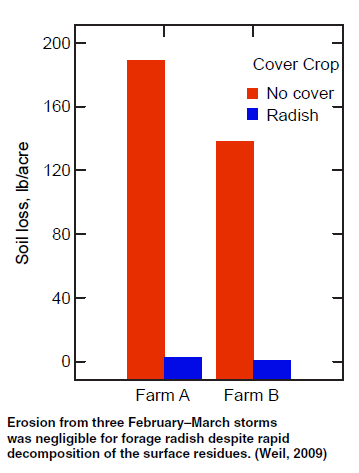
Figure 8. Impact of radish on soil loss. Figure credit: Ray Weil, University of Maryland.
Effects on Soil Organic Matter
Total dry matter production by radish cover crops can exceed 3.5 tons/ac (5000 lb/ac aboveground and 2,000 lb/ac below ground) after 2 months with favorable growing conditions (1.1 lb fresh weight per square foot at 90% moisture = 5000 lb/ac dry matter). It is important to keep in mind however that radish biomass is highly decomposable and increases in total soil organic matter (SOM) levels following radish cover crops are unlikely. More sensitive measures of SOM (e.g., microbial biomass C and particulate organic matter) may be able to detect changes in SOM resulting from radish cover cropping but little evidence has been reported to date.
Effects on Nematodes
Laboratory bioassays have shown that the residues of radishes and many other cover crops reduce the survival of plant parasitic nematodes such as root knot nematodes (Meloidogyne incognita) and soybean cyst nematodes (Heterodera glycines) compared to unamended controls. Unfortunately these effects are much less consistent in the field but some significant effects of radish have been reported.
In eastern Texas, researchers recently evaluated the effect of incorporating a wide variety of brassicas (Florida Broadleaf, Southern Giant, and Bionute White mustards, Graza radish, Purple Top turnip, Vates collards, and Dwarf Blue kale) 58 days before planting sweet potatoes. Graza reduced populations of root knot nematode more than all other treatments and also resulted in fewer ring nematodes at harvest than in the plots with no cover. In addition, ring nematode reproduction rate was lower in Graza plots than all other treatments (Steddom et al., 2008).
Radish cover crops have also been found to have some positive effects on beneficial nematodes. Research at the University of Maryland found that the winter-kill of N-rich radishes activated bacteria feeding nematodes in the early spring creating opportunities for rapid cycling of organic N (Gruver et al., 2010).
Effects on Crop Yields
On-farm comparisons and limited replicated trials in Maryland, Ohio, Pennsylvania, and Illinois (Fig. 9) have reported significant increases in corn and soybean yields following radishes as compared to fallow or other cover crops. These yield increases are likely the combined result of multiple effects described above.
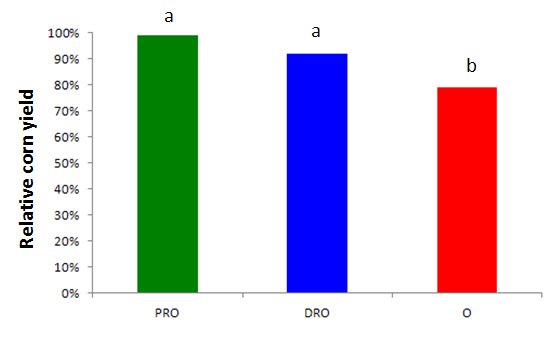
Figure 9. Impact of 3 cover crop systems: volunteer oats (O), volunteer oats with radishes planted on 30-inch rows (PRO) and volunteer oats with radishes drilled on 7.5-inch rows (DRO) on the relative yield of a following corn crop. Corn yields were not significantly different with radishes drilled at the two different row widths (a=0.05), but corn yields with radishes at both row widths were significantly greater than with oats alone. Figure credit: Joel Gruver, Western Illinois University.
Management of Cover Crop Radishes
Seeding
Good stands of radishes can be established by drilling 6–10 lb/ac or broadcasting at 8-12 lb/ac. When using a drill, seed should be placed ½–1 inch deep. When broadcasting, establishment is enhanced by culti-packing or light tillage. Aerial seeding has been successful using 10–16 lb/ac broadcast into standing corn and soybean canopies when soil surface moisture was favorable for germination for several days. It is important that the seedlings quickly have access to light so aerial seeding should not occur until the crop begins to senesce (~50% yellowing of lower leaves) and early harvest also improves growth. Mixing radish seed with other cover crop species (e.g., oats, annual ryegrass and/or crimson clover) can improve seed distribution and stand establishment and reduce total seed cost.
There is growing Interest in planting radishes on wider row spacings (Fig. 10), often in combination with other cover crop species. This can be accomplished by blocking off rows in a drill or using a planter with appropriate plates or another seed metering system appropriate for radish seed.
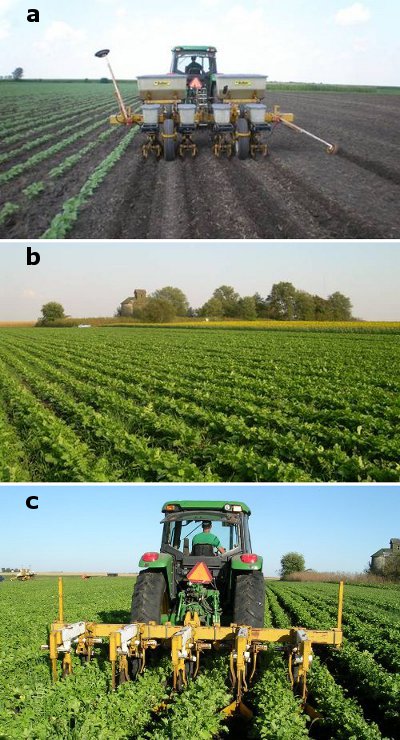
Figure 10. Radish planted on 30-inch rows at the WIU Organic research farm in Roseville, IL. (a) Planting radishes on 30-inch rows with a Buffalo planter. (b) Radish planted on 30-inch rows with some volunteer spring wheat. (c) Cultivation may be needed to control weeds in radishes planted on 30-inch rows without a companion species. Photo credits: Joel Gruver, Western Illinois University.
Establishing radishes with a planter has particular appeal because many farmers have wider planters than drills, seed spacing is more controlled than with a drill and lower seeding rates can be used. Specific planter plate recommendations are summarized in the following table (Table 1).
| Planter | Plate |
|---|---|
| White | 60-cell sugar beet |
| Deere | small sugar beet 4/64 inch |
| Case-IH | sugar beet |
| Kinze 2000 and 3000 series | small 60-cell milo |
| Kinze Edge Vac w/ e-sets | 60-cell small sugar beet 1/16 inch |
| Monosem | 6020 plate; vacuum set to 15 |
Radishes germinate rapidly, emerging within 3–4 days when environmental conditions are favorable. Seed broadcast on the surface can establish well if seeding is followed by a timely rain or irrigation. Radishes have a very flexible and aggressive growth habit and will spread out in a rosette to fill available space. Radish plants (roots and shoots) grow much larger at lower plant densities but it is not clear that giant specimens (e.g., greater than 3-inch diameter roots) have any advantage over good stands of radishes with 1-inch diameter roots (Fig. 11).
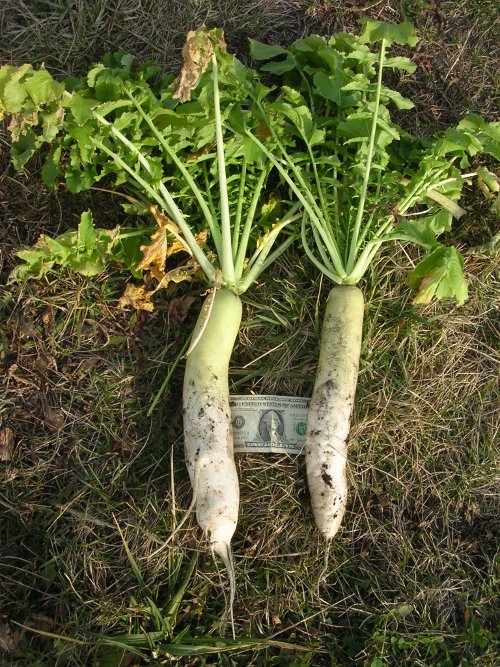
Figure 11. Typical radishes after about 60 days of growth with abundant water and nutrients—much larger radishes are possible but have more value at the county fair than in your fields. Photo credit: Joel Gruver, Western Illinois University.
Radishes grow best when planted early enough to allow 6 weeks of growth before regular frosts. Later-planted radishes tend to be more cold-hardy and less likely to winter-kill. When planted in the spring, most radishes bolt quickly producing much less root and shoot biomass than fall plantings.
Winter Hardiness
Radishes are tolerant of light frosts but generally show injury when temperatures drop below the mid-20s. In regions where winter temperatures regularly drop below 20 F, radishes normally winterkill but it should be noted that overwintering was reported at some northern locations in 2010 and 2012, likely due to early and persistent snowcover and unusually mild winter conditions, respectively. Young radishes in the rosette growth stage are more winter hardy than radishes that have developed a sizable storage root.
Crop Rotations
Radishes fit well following small grains, corn silage, and early harvested vegetable crops (e.g., sweet corn) that allow cover crop planting before September 1. Later plantings can scavenge significant amounts of N but may accomplish little biodrilling or weed suppression. Nutrients scavenged by radishes are released rapidly making radishes a good fit ahead of early planted crops with high nutrient requirements. Caution should be taken when adding radishes to rotations that already include brassicas.
Cover Crop Mixtures
Many farmers and researchers are experimenting with cover crop mixtures that combine radish with other cover crops that fix N, provide more persistent residues or simply have cheaper seed. As a general rule, radish rates should be cut by at least 50% when included in cover crop mixtures because of their capacity to out compete other species.
An alternative method of managing radish competition in mixtures is to plant separate rows of radishes and companion species (Fig. 12). This can be accomplished by blocking off or compartmentalizing the rows in the seed boxes of a grain drill or by attaching an additional seed metering/distribution system (e.g., Valmar airflo or Gandy Orbit-air). In addition, some farmers are using split-row planters to plant alternating rows of radish and companion species on 15-inch spacing or planting twice on 30" rows with a 15-inch off-set using GPS guidance.
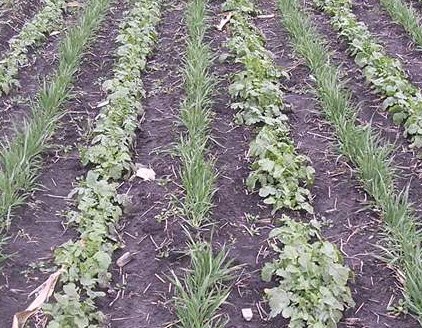
Figure 12. Alternating 15-inch rows of radish and oats. Photo credit: Joel Gruver, Western Illinois University.
Spring oats and sorghum-Sudangrass (Sudex) compete well with radish and provide longer lasting residues to immobilize some of the N released from radish residues in the spring. These additional residues may also help maintain soil moisture, reduce weed growth, and reduce erosion during the next growing season. When cereal rye is mixed with radish, the rye overwinters and scavenges N released by the decomposing radish. Hairy vetch is a winter-hardy legume that has also performed well interseeded with radish (both mixed and in separate rows).
Potential Problems
Radishes have little tolerance of wet soils, so planting in fields that collect standing water or are prone to prolonged wetness should be avoided. Enhanced growth directly over tile lines is common (Fig. 13) and plugging of tile lines has been reported but appears to be a rare occurrence.
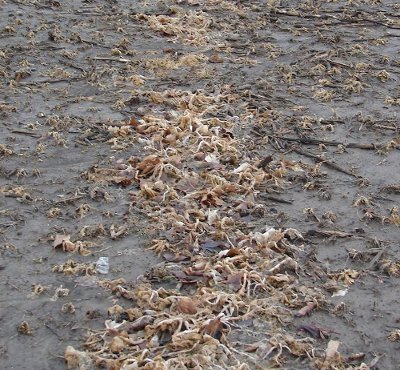
Figure 13. Larger radishes over a tile line on a farm in Western IL. Photo credit: Mike Roegge, University of Illinois Extension.
Radishes are very responsive to N, and N deficiency limits their ability to compete with weeds, grow through compacted soil, and perform other potential functions. Nitrogen deficiencies have been observed when planting after silage- or grain corn on sandy soils or on soils that do not have a history of manure application. N deficiencies are also likely when excessively high populations are established.
Radishes are only moderately cold hardy and need about 6 weeks of favorable growing conditions to produce sufficient biomass to achieve most potential benefits.
Lastly, be forewarned that rotting radish residues produce a powerful rotten egg-like odor, particularly during winter thaws.
Summary
Radishes have much potential to perform valuable functions within organic cropping systems. Realization of this potential depends upon timely establishment, favorable environmental conditions, and adequate fertility. As described in this article, a solid research foundation supports the value of radishes as a cover crop but farmer innovation is needed to fine-tune strategies for integrating radishes in specific organic cropping systems.

Figure 14. Lead author appreciating a good stand of radishes in Maryland. Photo credit: Joel Gruver, Western Illinois University.
References and Citations
Chen, G., and R. R. Weil. 2010. Penetration of cover crop roots through compacted soils. Plant and Soil 331: 31–43. (Available online at: http://dx.doi.org/10.1007/s11104-009-0223-7) (verified 21 Feb 2011).
Dean, J. E., and R. R. Weil. 2009. Brassica cover crops for nitrogen retention in the Mid-Atlantic coastal plain. Journal of Environmental Quality 38: 520–528. (Available online at: http://dx.doi.org/10.2134/jeq2008.0066) (verified 21 Feb 2011).
Gruver, L. S., R. R. Weil, I. A. Zasada, S. Sardanelli, and B. Momen. 2010. Brassicaceous and rye cover crops altered free-living soil nematode community composition. Applied Soil Ecology 45: 1–12. (Available online at: http://dx.doi.org/10.1016/j.apsoil.2009.11.007) (verified 21 Feb 2011).
Lawley, Y. E., R. R. Weil, and J. R. Teasdale. 2011. Forage radish cover crop suppresses winter annual weeds in fall and before corn planting. Agronomy Journal 103: 137–144. (Available online at: http://dx.doi.org/10.2134/agronj2010.0187) (verified 21 Feb 2011).
Ngouajio, M, and D. R. Mutch, 2004. Oilseed Radish: A new cover crop for Michigan. Bulletin E2907. East Lansing: Michigan State University Extension. (Available online at: https://www.canr.msu.edu/resources/oilseed_radish_a_new_cover_crop_for_michigan_e2907) (verified 24 Dec 2019)
Steddom, K, K. Ong, and J. Starr. 2008. Efficacy of various brassica varieties for the suppression of root knot, ring, and stunt nematodes. Phytopathology 98: S150. (Available online at: http://dx.doi.org/10.1094/PHYTO.2008.98.6.S9) (verified 21 Feb 2011).
Stewart, A. V., and A. J. Moorhead. 2004. The development of a fodder radish suitable for multiple grazing. Proceedings of the Thirty-fourth Annual Conference, Agronomy Society of New Zealand, Ashburton, New Zealand.
Weil, R. R., and A. Kremen. 2007. Thinking across and beyond disciplines to make cover crops pay. Journal of the Science of Food and Agriculture 87: 551–557. (Available online at: http://dx.doi.org/10.1002/jsfa.2742) (verified 21 Feb 2011).
White, C. M., and R. R. Weil. 2011. Forage radish cover crops increase soil test P surrounding holes created by the radish taproots. Soil Science Society of America Journal 75: 121–130. (Available online at: http://dx.doi.org/10.2136/sssaj2010.0095) (verified 21 Feb 2011).
White, C. M., and R. R. Weil. 2010. Forage radish and cereal rye cover crop effects on mycorrhizal fungus colonization of maize root. Plant and Soil 328: 507–521. (Available online at: http://dx.doi.org/10.1007/s11104-009-0131-x) (verified 21 Feb 2011).
Additional Resources
Chen, G. 2009. Alleviation of soil compaction by Brassica cover crops. PhD Dissertation. University of Maryland. (Available online at: http://www.lib.umd.edu/drum/bitstream/1903/9517/1/Chen_umd_0117E_10536.pdf). (verified 13 Feb 2012).
Gruver, L. S. 2007. Soil nematode communities as influenced by cover crops, with a focus on Brassicaceae. M.S. thesis. University of Maryland. (Available online at: http://hdl.handle.net/1903/7028) (verified 13 Feb 2012).
Kremen, A. 2006. Nitrogen mineralization from Brassica cover crops. MS. thesis. University of Maryland. (Available online at: http://www.lib.umd.edu/drum/bitstream/1903/3821/1/umi-umd-3666.pdf) (verified 13 Feb 2012).
Lawley, Y. 2010. Weed suppression by forage radish winter cover crops. PhD thesis. University of Maryland. (Available online at: http://hdl.handle.net/1903/10414) (verified 13 Feb 2012).
Mutegi, J. K., B. M. Petersen, L. J. Munkholm, and E. M. Hansen. 2011. Belowground carbon input and translocation potential of fodder radish cover-crop. Plant and Soil 344: 159–175. (Available online at: http://dx.doi.org/10.1007/s11104-011-0737-7) (verified 21 Feb 2011).
Weil, R. R., C. M. White, and Y. Lawley. 2009. Forage radish: New multi-purpose cover crop for the mid-Atlantic. Fact sheet 824. Maryland Cooperative Extension, University of Maryland. (Available online at: http://covercrop.org/wp-content/uploads/2016/05/Weil_radish.pdf) (verified 24 Dec 2019).
White, C. M. 2009. Forage radish cover crop effects on mycorrhizal colonization and soil test phosphorus. M.S. thesis. University of Maryland. (Available online at: http://hdl.handle.net/1903/9333) (verified 13 Feb 2012).



